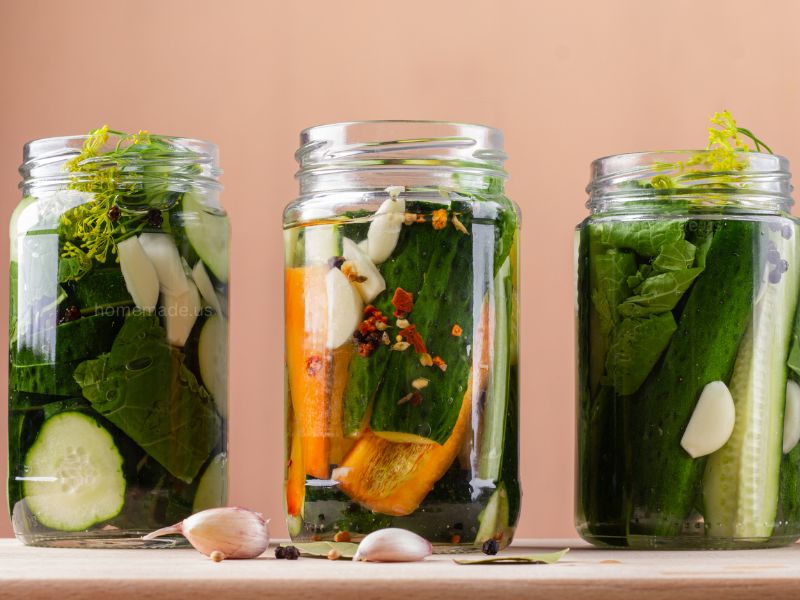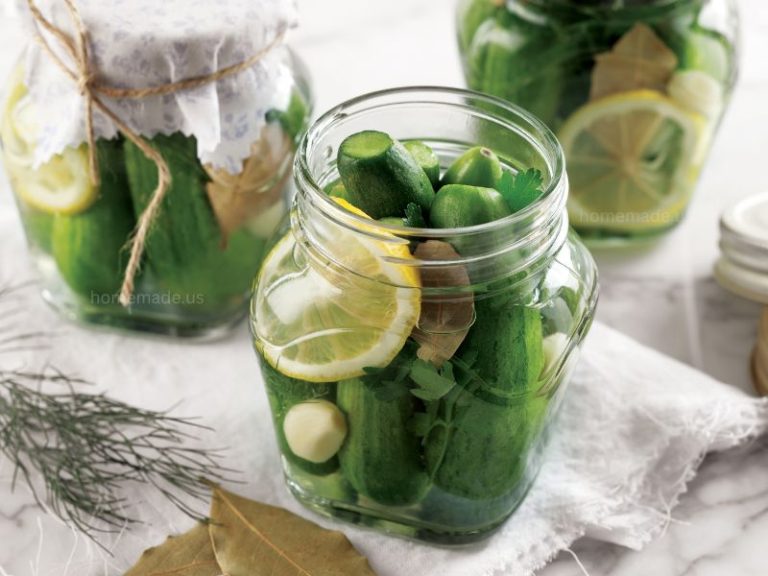Why hello there! I’m your trusty culinary guide, here to take you on a flavorful journey through the world of pickling and lacto-fermentation. Fasten your seatbelts, folks, and prepare to dive into the tangy, funky world of food preservation.
First things first, let’s talk pickling. Pickling is the art of preserving food by submerging it in a solution of vinegar and salt. Vinegar, being the acidic, sassy diva that it is, creates an environment too hostile for most bacteria to survive. As a result, your food is preserved for a long, long time (just like my youthful appearance, wink wink). It’s been said that Cleopatra, who knew a thing or two about beauty, attributed her stunning looks to her love of pickles.
Now, on to lacto-fermentation, the lesser-known, enigmatic cousin of pickling. In this process, we let our helpful bacterial buddies do the heavy lifting. When submerging food in a saltwater brine, the naturally occurring Lactobacillus bacteria get to work on the carbohydrates, converting them into lactic acid. It’s like a little bacterial dance party, and lactic acid is the hit single they can’t stop playing.
The lactic acid produced during lacto-fermentation lowers the pH level of the brine, creating an environment that’s inhospitable to harmful bacteria. This method not only preserves the food but also gifts it with a tangy flavor, a delightful crunch, and a host of probiotics that will make your gut sing.
When it comes to flavor, pickling and lacto-fermentation are like two sides of the same coin. Pickling provides that signature, lip-puckering tang that we all know and love (or hate, depending on your taste buds). Lacto-fermented foods, on the other hand, often have a more complex, nuanced flavor profile that’s been described as “funky,” “earthy,” or even “barnyardy.” Let’s just say, lacto-fermentation is like the hipster of food preservation.
In terms of health benefits, lacto-fermented foods might have a slight edge over their pickled counterparts. The probiotics created during lacto-fermentation can help promote a healthy gut, which is all the rage these days. I mean, who wouldn’t want a happy, healthy microbiome?
So there you have it, my foodie friends: pickling and lacto-fermentation, the dynamic duo of food preservation. Whether you’re team vinegar or team bacteria, there’s no denying that both methods offer a scrumptious way to enjoy your favorite veggies and fruits long after their peak season has passed. Remember, folks, variety is the spice of life – or in this case, the tang!
Here are two pickle recipes using cucumbers, one for pickling and one for lacto-fermentation, to help highlight the differences between the methods:
Classic Dill Pickles (Pickling)
Ingredients:
- 2 pounds of pickling cucumbers (small to medium-sized)
- 4 cups of water
- 2 cups of white vinegar
- 2 tablespoons of pickling salt (non-iodized)
- 4 cloves of garlic, peeled and lightly crushed
- 4 teaspoons of dill seeds (or 8 sprigs of fresh dill)
- 2 teaspoons of black peppercorns
- 1 teaspoon of red pepper flakes (optional, for a spicy kick)
Instructions:
- Wash and dry the cucumbers, then trim off the blossom ends (the ends opposite the stems). This helps to prevent mushy pickles. You can leave them whole or slice them into rounds, spears, or any shape you prefer.
- In a saucepan, combine the water, vinegar, and pickling salt. Heat the mixture over medium heat, stirring occasionally, until the salt dissolves. Remove from heat and allow the brine to cool to room temperature.
- In each of the two sterilized quart-sized jars (or four pint-sized jars), place two crushed garlic cloves, 2 teaspoons of dill seeds (or 4 sprigs of fresh dill), 1 teaspoon of black peppercorns, and ½ teaspoon of red pepper flakes (if using).
- Pack the cucumbers tightly into the jars, making sure to leave about ½ inch of headspace at the top.
- Pour the cooled brine over the cucumbers, ensuring they are fully submerged. If needed, use a clean utensil to press the cucumbers down and release any air bubbles.
- Seal the jars with airtight lids and refrigerate for at least 48 hours. The pickles will reach their peak flavor after about two weeks. Keep refrigerated and enjoy within three months for optimal crunch and taste.

Lacto-Fermented Dill Pickles
Ingredients:
- 2 pounds of pickling cucumbers (small to medium-sized)
- 4 cups of water
- 2 tablespoons of non-iodized salt (sea salt, kosher salt, or pickling salt)
- 4 cloves of garlic, peeled and lightly crushed
- 4 teaspoons of dill seeds (or 8 sprigs of fresh dill)
- 2 teaspoons of black peppercorns
- 1 teaspoon of red pepper flakes (optional, for a spicy kick)
- 4 grape or oak leaves (optional, to help maintain crispness)
Instructions:
- Wash and dry the cucumbers, then trim off the blossom ends (the ends opposite the stems). This helps to prevent mushy pickles. You can leave them whole or slice them into rounds, spears, or any shape you prefer.
- In a pitcher or large bowl, combine the water and salt, stirring until the salt dissolves to create a brine.
- In each of the two sterilized quart-sized jars (or four pint-sized jars), place two crushed garlic cloves, 2 teaspoons of dill seeds (or 4 sprigs of fresh dill), 1 teaspoon of black peppercorns, ½ teaspoon of red pepper flakes (if using), and 2 grape or oak leaves (if using).
- Pack the cucumbers tightly into the jars, making sure to leave about ½ inch of headspace at the top.
- Pour the brine over the cucumbers, ensuring they are fully submerged. If needed, use a small plate or a glass weight to keep the cucumbers pressed down and submerged in the brine.
- Cover the jars with a clean cloth or an airlock lid to allow gases to escape while keeping contaminants out.
- Store the jars at room temperature (65-75°F) and away from direct sunlight. Check on them daily, pressing down the cucumbers if needed to keep them submerged in the brine.
- After about 1 week, taste the pickles to see if they have reached your desired level of tanginess. If not, allow them to ferment for a few more days, up to 3 weeks total.
- Once you’re happy with the flavor, transfer the jars to the refrigerator to slow down the fermentation process. The lacto-fermented pickles can be enjoyed for several months, as long as they remain submerged in the brine and refrigerated.
In Conclusion
My fellow food enthusiasts, we’ve embarked on a tangy, flavor-packed journey through the worlds of pickling and lacto-fermentation. By exploring these two distinct methods of food preservation, we’ve discovered their unique properties and the resulting flavor profiles they impart on our beloved cucumbers.
Our classic dill pickle recipe, which utilizes the pickling method, combines vinegar, salt, and a delightful medley of spices to create a lip-puckering, crunchy treat. The acidic environment created by the vinegar ensures long-term preservation and imparts that signature tang that is characteristic of pickled foods.
On the other hand, our lacto-fermented dill pickle recipe relies on the power of saltwater brine and the mighty Lactobacillus bacteria to work their magic. These microscopic maestros transform the cucumbers into delectable, probiotic-rich pickles with a complex, earthy flavor that can only come from the fermentation process.
Despite their differences, both pickling and lacto-fermentation share a common goal: to preserve and enhance the taste of our favorite foods, allowing us to enjoy them long after their peak season has passed. Whether you’re a fan of the vinegar-based tang of pickled foods or the subtle, complex funkiness of lacto-fermented treats, there’s no denying that these time-honored techniques bring a world of flavor to our plates. So, go forth and experiment with these preservation methods, and remember to savor the tangy, crunchy delights that await you!
© 2016-2023 by Homemade.us. All rights reserved. No part of this document may be reproduced or transmitted in any form or by any means, electronic, mechanical, photocopying, recording, or otherwise, without prior written permission of Homemade.us.

Leave a Reply